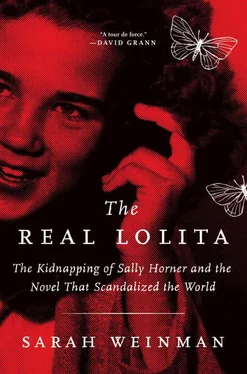And that he would find Frank La Salle and see justice done.

Vladimir Nabokov holding a butterfly, 1947, at Harvard’s Museum of Comparative Zoology, where he was a fellow.
As Marshall Thompson continued to track Frank La Salle’s whereabouts without results, Vladimir Nabokov remained on a quest to plumb the fictional mind of a man with a similar appetite for young girls. So far, he had not been successful. He could have, and tried to, abandon it altogether—there were plenty of other literary projects for Nabokov to pursue. But the drive to get this story right went beyond formal exercise. Otherwise, why did Nabokov explore this same topic, over and over, for more than twenty years? At almost every stage of his literary career, Nabokov was preoccupied with the idea of the middle-aged man’s obsession with a young girl.
As Martin Amis wrote in a 2011 essay for the Times Literary Supplement, “Of the nineteen fictions, no fewer than six wholly or partly concern themselves with the sexuality of prepubescent girls…. [T]o be clear as one can be: the unignorable infestation of nymphets… is not a matter of morality; it is a matter of aesthetics. There are just too many of them.”
“Aesthetics” is one way to phrase it. Robert Roper, in his 2015 book Nabokov in America, suggested a more likely culprit: compulsion—“a literary equivalent of the persistent impulse of a pedophile.” Over and over, scholars and biographers have searched for direct connections between Nabokov and young children, and failed to find them. What impulses he possessed were literary, not literal, in the manner of the “well-adjusted” writer who persists in writing about the worst sort of crimes. We generally don’t bear the same suspicions of writers who turn serial killers into folk heroes. No one, for example, thinks Thomas Harris capable of the terrible deeds of Hannibal Lecter, even though he invented them with chilling psychological insight.
Nabokov likely realized how often this theme persisted in his work. That would explain why he was quick to deny connections between Lolita and real-life figures, or to later claim the novel’s inspiration emerged from, of all things, a brief article in a French newspaper about “an ape in the Jardin des Plantes who, after months of coaxing by a scientist, produced the first drawing ever charcoaled by an animal: this sketch showed the bars of the poor creature’s cage.”
But there is no getting around the deep-seated compulsion that recurs again and again in Nabokov’s work. I read through his earlier Russian-language novels, as well as more contemporary accounts by literary critics, to figure out why this awful subject held such allure for him.
NABOKOV’S INITIAL EXPLORATION of an older man’s unnatural desire for a preteen girl was published in 1926, within the first year of his career as a prose writer. Before then, he devoted himself exclusively to poetry. Did prose free Nabokov up to wrestle with the darkness and tumult that already surrounded him? His father, the jurist and journalist Vladimir D. Nabokov, had been assassinated four years earlier, and he was a year into his marriage to Véra Slonim, a fellow émigré he met while both lived in Berlin among the community of other Russians who’d fled the Revolution. Neither particularly cared for the city, but they stayed in Berlin for fifteen years, Nabokov supplementing his writing income and growing literary reputation by teaching tennis, boxing, and foreign languages to students.
Nabokov published his first novel, Mashen’ka ( Mary ), in 1926, under the pseudonym of V. Sirin, which he would use for all of his poetry and prose published before he moved to America. That same year Nabokov, as Sirin, published “A Nursery Tale.” The short story includes a section on a fourteen-year-old girl clad in a grown-up cocktail dress designed to show off her cleavage, though it isn’t clear that the narrator, Erwin, immediately notices that aspect:
“There was something odd about that face, odd was the flitting glance of her much too shiny eyes, and if she were not just a little girl—the old man’s granddaughter, no doubt—one might suspect her lips were touched up with rouge. She walked swinging her hips very, very slightly, her legs moved closer together, she was asking her companion something in a ringing voice—and although Erwin gave no command mentally, he knew that his swift secret wish had been fulfilled.”
Erwin’s “swift secret wish” is his inappropriate desire for the girl.
Two years later, in 1928, Nabokov tackled the subject in poetry. “Lilith” also strongly features the so-called demonic effect of a little girl, of her “russet armpit” and a “green eye over her shoulder” upon an older man: “She had a water lily in her curls and was as graceful as a woman.” The poem continues:
And how enticing, and how merry,
her upturned face! And with a wild
lunge of my loins I penetrated
into an unforgotten child.
Snake within snake, vessel in vessel
smooth-fitting part, I moved in her,
through the ascending itch forefeeling
unutterable pleasure stir.
But this illicit coupling is the man’s ruin. Lilith closed herself off to him and forced him out, and as he shouts, “let me in!” his fate is sealed: “The door stayed silent, and for all to see / writhing with agony I spilled my seed / and knew abruptly that I was in Hell.” Two and a half decades before Lolita, Nabokov anticipated Humbert Humbert’s remark that he was “perfectly capable of intercourse with Eve, but it was Lilith he longed for.”
Another proto-nymphet appears in Laughter in the Dark, though this one, Margot, is a little older: eighteen in the original version published in Russian, Camera Obscura (1932), and sixteen in the heavily revised and retitled edition Nabokov released six years later. (Nabokov rewrote the novel a third time in the 1960s.) Margot attracts the attention of the much-older, wealthy art critic Albert Albinus, [1] In the original Russian, Albinus was called Bruno Kretchmar, while Margot’s name was Magda.
whose name foreshadows Humbert Humbert.
We only see Margot’s actions and personality filtered through Albinus’s eyes. He depicts her as capricious, whimsical, and full of manipulation. Just as in Lolita, when Humbert’s plans are upended by the arrival of Clare Quilty, an interloper foils the relationship between Albinus and Margot. Axel Rex’s affair with Margot in Laughter in the Dark serves a more mercenary purpose—gaining access to Albinus’s status and fortune—while Quilty is after Dolores for the same illicit reasons as Humbert Humbert.
Except for Margot, who is a proper character, the early precursors to Dolores Haze are merely images that tempt and torment Nabokov’s male protagonists. The image grows in substance in tandem with Nabokov’s artistic growth. A paragraph in Dar, written between 1935 and 1937 but not published until 1952 (the English translation, published as The Gift, appeared a decade later), all but summarizes the future plot of Lolita . “What a novel I would whip off!” declares a secondary character, contemplating his much, much younger stepdaughter:
Imagine this kind of thing: an old dog—but still in his prime, fiery, thirsting for happiness—gets to know a widow, and she has a daughter, still quite a little girl—you know what I mean—when nothing is formed yet but she has a way of walking that drives you out of your mind—A slip of a girl, very fair, pale with blue under the eyes—and of course she doesn’t even look at the old goat. What to do? Well, not long [after] he ups and marries the widow. Okay. They settle down, the three of them. Here you can go on indefinitely—the temptation, the torment, the itch, the mad hopes…
Читать дальше













